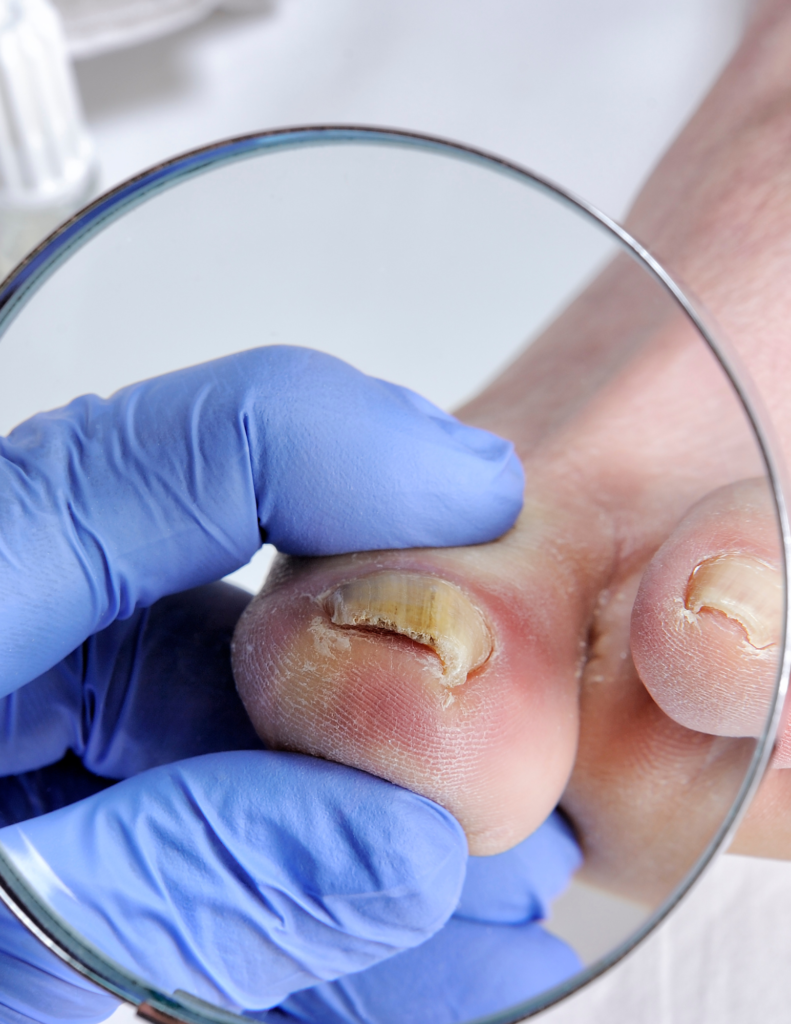What are the White Patches on my Toenails?
Noticing white patches on your toenails can be a source of concern and curiosity, prompting questions about their cause and how they can be treated. These patches, ranging from minor cosmetic issues to signs of underlying health conditions such as onychomycosis, are more common than you might think. At Red Mountain Footcare, we understand the importance of addressing these concerns with accurate information and expert care. We’ll explore the common causes of white patches on toenails, effective treatment options, and when it’s crucial to seek professional advice, ensuring you have the knowledge to maintain healthy feet.
What is Leukonychia?
Leukonychia, often recognized as white spots or patches on the nails, is a condition that can arise from a variety of factors, including minor trauma or injury to the nail bed. While commonly believed to be indicative of nutritional deficiencies, particularly calcium and zinc, leukonychia can also result from an allergic reaction to nail products or systemic health issues. Unlike onychomycosis, which is a fungal infection, leukonychia is typically harmless and may resolve on its own as the nail grows out. However, persistent or widespread white patches could signal underlying health concerns, necessitating a consultation with a medical professional for accurate diagnosis and advice. Understanding the distinction between leukonychia and other conditions like onychomycosis is crucial for effective treatment and maintaining nail health.
Common Causes of White Patches on Nails
Discovering white patches on your toenails can be unsettling, with several underlying causes contributing to this phenomenon.
-
Minor Trauma or Injury
- Even slight bumps or knocks can disrupt nail growth, leading to white spots as the nail heals.
-
Allergic Reactions
- Nail polish, hardeners, or other cosmetic products can cause allergic reactions which manifest as discolored spots.
-
Onychomycosis
- A higher cause for concern, a toenail fungal infection characterized by white, yellow, or brown patches on the nail, signaling the need for targeted treatments.
-
Stress
- Stress can impact nail health, potentially exacerbating conditions that lead to discoloration.
-
Nutritional Deficiency
- In particular, zinc plays a significant role in the health of your nails, it has been specifically linked to the appearance of white patches.
Taking a Closer Look at Onychomycosis
Onychomycosis, commonly known as toenail fungus, is a prevalent condition that leads to the appearance of white, yellow, or brown patches on the nail, often accompanied by thickening and brittleness. This fungal infection is caused by various fungi, with dermatophytes being the most common culprits, thriving in warm, moist environments such as showers and swimming pools. Early detection is key to managing onychomycosis effectively, as the infection can spread to other nails and even the skin if left untreated. Treatment options vary from topical antifungal creams and ointments to oral medications, depending on the severity of the infection and the patient’s overall health. Adopting preventive measures, such as maintaining dry and clean feet, wearing breathable footwear, and using antifungal sprays or powders, can significantly reduce the risk of developing onychomycosis.
Treatment and Prevention
Treating onychomycosis effectively requires a multifaceted approach, starting with antifungal medications, which can be prescribed in topical form for mild cases or oral form for more severe infections. Over-the-counter treatments and home remedies also play a role in managing symptoms, with options like tea tree oil and vinegar baths offering supplementary support to conventional treatments. Preventing onychomycosis is equally critical, with strategies including maintaining foot hygiene, wearing breathable shoes, and keeping feet dry to discourage fungal growth. Regularly changing socks and shoes, especially after activities that cause sweating, and using antifungal powders can further reduce the risk of infection. For those who frequent gyms or swimming pools, wearing shower shoes in communal areas is a recommended precaution to avoid contracting and spreading the fungus responsible for onychomycosis.
When to Seek a Medical Professional
Recognizing when to consult a healthcare provider is crucial in effectively addressing white patches on toenails, especially if these patches are accompanied by symptoms of onychomycosis, such as pain, swelling, or a foul odor, indicating a possible fungal infection. If over-the-counter treatments and home remedies have been ineffective in resolving the white patches, it’s time to seek professional diagnosis and treatment to explore more targeted solutions. Persistent or worsening symptoms, including spreading of the discoloration to other nails or the surrounding skin, should prompt an immediate visit to a medical professional. Individuals with underlying health conditions, like diabetes or immune system disorders, should particularly heed any changes in their toenail appearance, as these could signify more serious complications. Moreover, if the cause of the white patches is uncertain or if there’s suspicion of nutritional deficiencies contributing to the issue, professional guidance can offer the necessary testing and advice to address the root cause.
Foot and Nail Specialists at Red Mountain Footcare
Understanding the various causes behind white patches on toenails, from minor injuries to conditions like onychomycosis, is the first step towards effective treatment and prevention. At Red Mountain Footcare, we’re dedicated to providing you with the expertise and care needed to maintain optimal foot health. Whether you’re seeking treatment options or need advice on prevention strategies, our team is here to support you every step of the way. Don’t let toenail concerns slow you down; contact us today to schedule your consultation and take the first step towards healthier feet.
